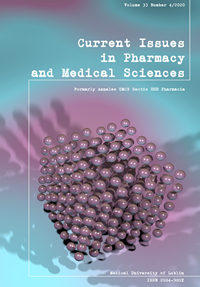Walnut Kernel administration to mothers during pregnancy and lactation improve learning of their pups. Changes in number of neurons and gene expression of NMDA receptor and BDNF in hippocampus in 80 days rat pups
DOI:
https://doi.org/10.2478/cipms-2020-0031Keywords:
rat, memory, learning, offspring, BDNF, NMDA-RAbstract
Walnut (Juglans regia) from the Juglandaceae family contains high levels of omega 3 fatty acid, vitamin E and melatonin, hence its consumption is beneficial to would be mothers and their offspring. The current study was designed to determine the possible mechanism of walnut consumption by mothers during pregnancy and lactation and the positive effects on learning and memory processes in their offspring. Wistar adult female rats were placed into three groups: control (fed with pellet, 20 g daily during pregnancy and lactation), CASE 1 [fed with Walnut Kernel (WK) 6% of food intake during pregnancy and lactation] and CASE 2 (fed with WK, 9% of food intake during gestation and lactation). In order to evaluate offspring learning and memory, the Morris Water Maze (MWM) test was performed for their adult offspring at 80 days of age. Histological and molecular studies were utilized in order to discover the protective mechanism and efficacy of WK consumption. The results revealed that learning was significantly improved in the females of CASE 2, in comparison to controls, while there was no difference in memory among the different groups. In addition, the number of neurons significantly increased in the CASE 2 group compared to the control group. However, the molecular study demonstrated that there was no significant difference among the study groups. The results herein show that feeding mothers with WK may improve the learning competence of their pups and increase the number of neurons in both sexes.
References
1. Toole MJ, Renzaho A. Transient benefits in young children of a nutrition intervention during pregnancy. The Lancet Glob Health. 2014;2(11):e621-e2.
2. Cunha AJLAd, Leite ÁJM, Almeida ISd. The pediatrician’s role in the first thousand days of the child: the pursuit of healthy nutrition and development. J Pediatr (Rio).2015;91(6):S44-S51.
3. Akerele OA, Cheema SK. A balance of omega-3 and omega-6 polyunsaturated fatty acids is important in pregnancy. J Nutr Intermed Metab. 2016;5:23-33.
4. Sherry C, Oliver J, Marriage B. Docosahexaenoic acid supplementation in lactating women increases breast milk and plasma docosahexaenoic acid concentrations and alters infant omega 6: 3 fatty acid ratio. Prostaglandins Leukot Essent Fatty Acids. 2015;95:63-9.
5. Rehman MU, Wali AF, Ahmad A, Shakeel S, Rasool S, Ali R, et al. Neuroprotective strategies for neurological disorders by natural products: An update. Curr Neuropharmacol. 2019;17(3):247-67.
6. Poulose SM, Miller MG, Shukitt-Hale B. Role of Walnuts in maintaining brain health with age. J Nutr. 2014;144(4):561S-6S.
7. Pribis, P, Bailey RN, Russell, AA, Kilsby MA, Hernandez M, Craig WJ, et al. Effects of walnut consumption on cognitive performance in young adults. Br J Nutr. 2012;107(09):1393-401.
8. Asadi-Shekaari, M, Kalantaripour TP, Nejad FA, Namazian E, Eslami A. The anticonvulsant and neuroprotective effects of walnuts on the neurons of rat brain cortex. Avicenna J Med Biotechnol. 2012;4(3):155.
9. Asadi-Shekaari, M, Karimi A, Shabani M, Sheibani V, Esmaelipour K. Maternal feeding with walnuts (Juglans regia) improves learning and memory in their adult pups. Avicenna J Phytomed. 2013;3(4):341-6.
10. Duvernoy, HM. The human brain: surface, three-dimensional sectional anatomy with MRI, and blood supply. Springer Science & Business Media; 2012.
11. Henke K, Buck A, Weber B, Wieser HG. Human hippocampus establishes associations in memory. Hippocampus. 1997;7(3):249-56.
12. Guo T, Winterburn JL, Pipitone J, Duerden EG, Park MTM, Chau V, et al. Automatic segmentation of the hippocampus for preterm neonates from early-in-life to term-equivalent age. Neuro Image Clin. 2015;9:176-93.
13. Yamada K, Mizuno M, Nabeshima T. Role for brain-derived neurotrophic factor in learning and memory. Life Sci. 2002;70(7): 735-44.
14. Paoletti P, Bellone C, Zhou Q. NMDA receptor subunit diversity: impact on receptor properties, synaptic plasticity and disease. Nat Rev Neurosci. 2013;14(6):383-400.
15. Zihayat B, Khodadadi A, Torabi M, Mehdipour M, Basiri M, Asadi-Shekaar M. Wound healing activity of sheep’s bladder extracellular matrix in diabetic rats. Biomed Eng-App Bas C. 2018;30(2):18500151-8.
16. Haider S, Batool Z, Tabassum S, Perveen T, Saleem S, Naqvi F, et al. Effects of walnuts (Juglans regia) on learning and memory functions. Plant Foods Hum Nutr. 2011;66(4):335-40.
17. Guesnet P, Alessandri J-M. Docosahexaenoic acid (DHA) and the developing central nervous system (CNS)–implications for dietary recommendations. Biochimie. 2011;93(1):7-12.
18. Umezawa M, Ohta A, Tojo H, Yagi H, Hosokawa M, Takeda T. Dietary α-linolenate/linoleate balance influences learning and memory in the senescence-accelerated mouse (SAM). Brain Res. 1995;669(2):225-33.
19. Innis SM. Fatty acids and early human development. Early Hum Dev. 2007;83(12):761-6.
20. Herrera E. Implications of dietary fatty acids during pregnancy on placental, fetal and postnatal development – a review. Placenta. 2002; 23:S9-S19.
21. de Souza AS, Rocha MS, do Carmo MdGT. Effects of a normolipidic diet containing trans fatty acids during perinatal period on the growth, hippocampus fatty acid profile, and memory of young rats according to sex. Nutrition. 2012;28(4):458-64.
22. Kesse-Guyot E, Fezeu L, Jeandel C, Ferry M, Andreeva V, Amieva H, et al. French adults’ cognitive performance after daily supplementation with antioxidant vitamins and minerals at nutritional doses: a post hoc analysis of the Supplementation in Vitamins and Mineral Antioxidants (SU. VI. MAX) trial. Am J Clin Nutr. 2011;94(3):892-9.
23. Zimmer L, Vancassel S, Cantagrel S, Breton P, Delamanche S, Guilloteau D, et al. The dopamine mesocorticolimbic pathway is affected by deficiency in n − 3 polyunsaturated fatty acids. Am J Clin Nutr. 2002;75(4):662-7.
24. Jackowski S. Cell cycle regulation of membrane phospholipid metabolism. J Biol Chem. 1996;271(34):20219-25.
25. Liu L, Wong TP, Pozza MF, Lingenhoehl K, Wang Y, Sheng M, Auberson YP, Wang YT. Role of NMDA receptor subtypes in governing the direction of hippocampal synaptic plasticity. Science. 2004;304(5673):1021-4.
26. Miller MG, Thangthaeng N, Poulose SM, Shukitt-Hale B. Role of fruits, nuts, and vegetables in maintaining cognitive health. Exp Gerontol. 2017;94:24-28.
Downloads
Published
Issue
Section
License
Copyright (c) 2021 Authors

This work is licensed under a Creative Commons Attribution-NonCommercial-NoDerivatives 3.0 Unported License.


